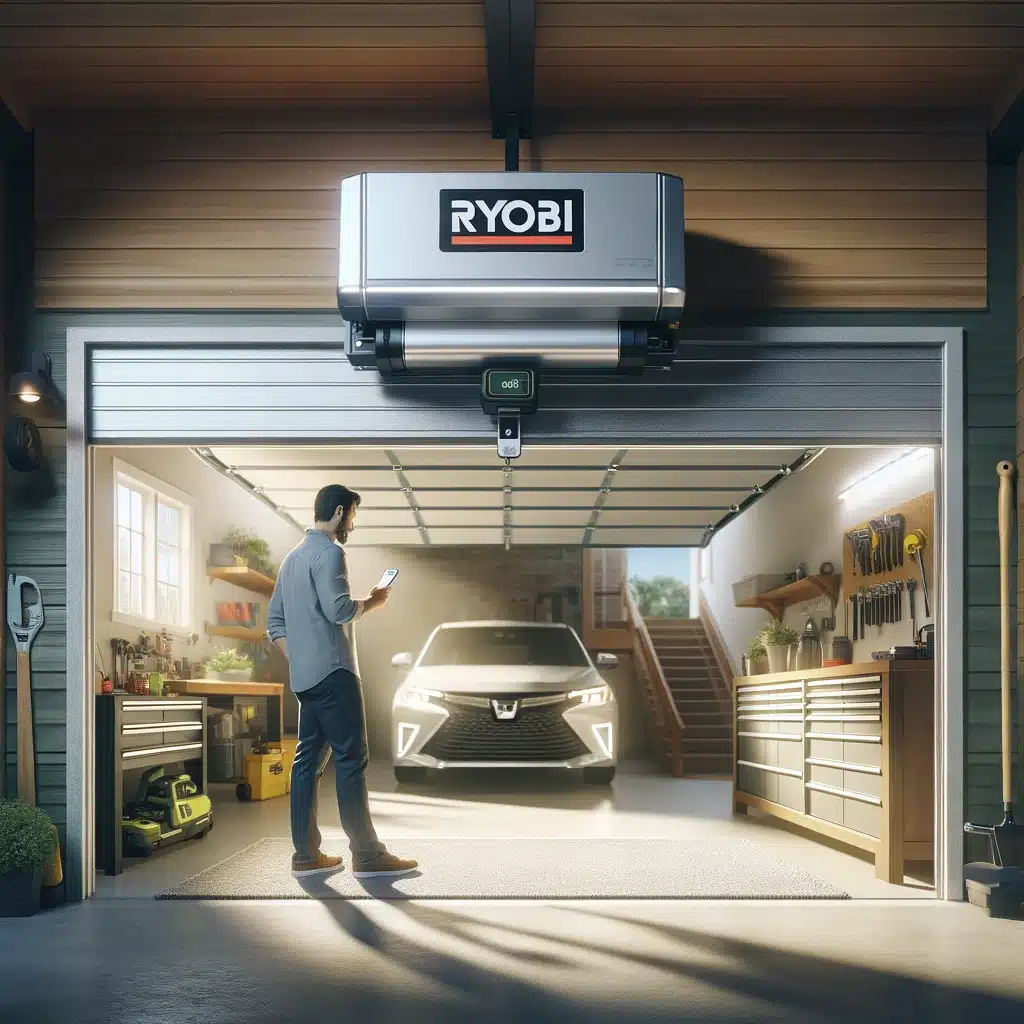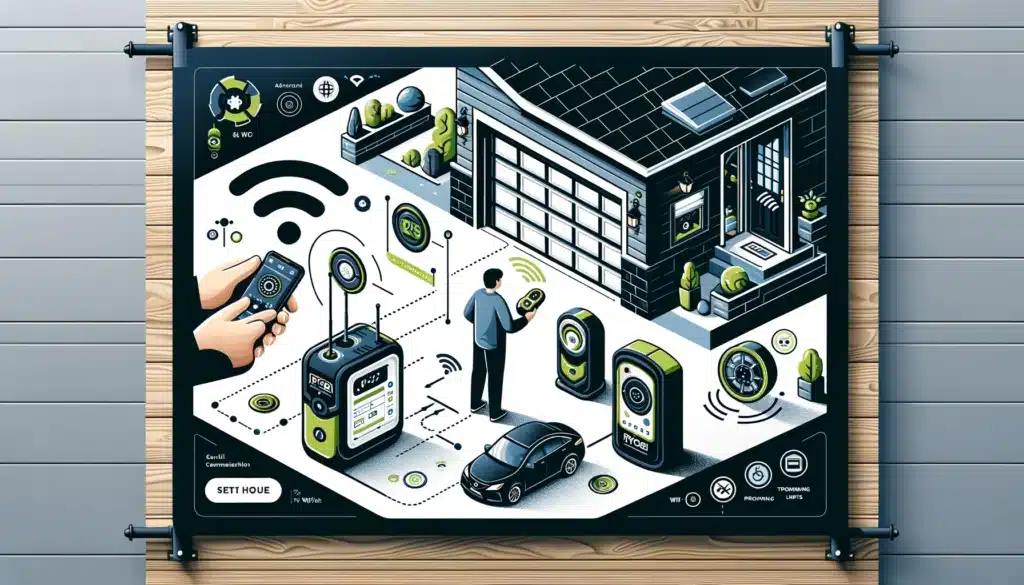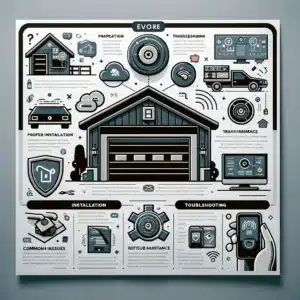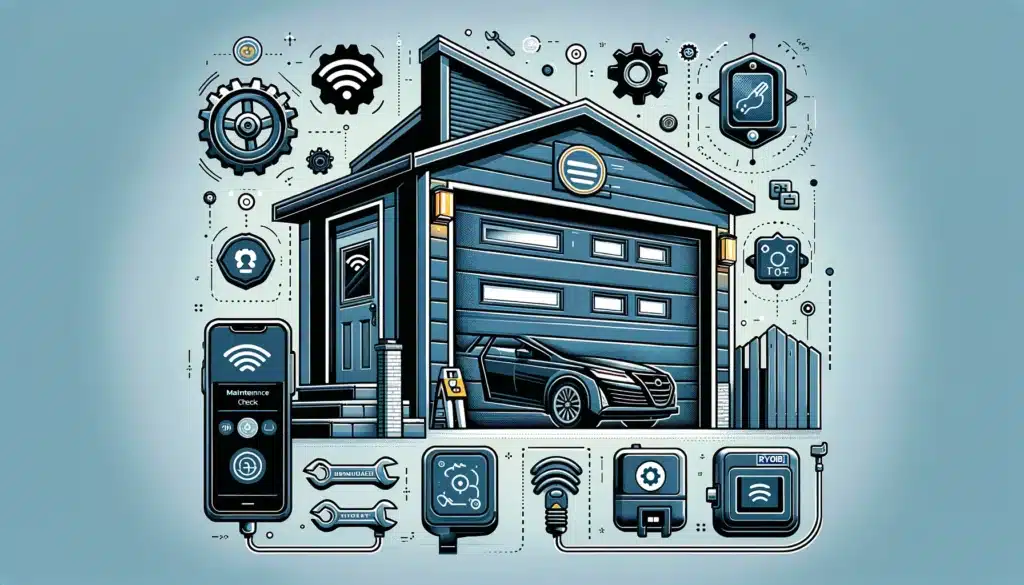When it comes to Ryobi garage door openers, many tips and tricks can help homeowners get the most out of these popular automated garage door systems. In this article, we will explore some of the best ways to maximize the convenience and capabilities of Ryobi garage door openers.
From programming and maintenance recommendations to troubleshooting common issues, this guide will provide garage door owners with useful advice to enhance their Ryobi system.

Whether you’ve just installed a new Ryobi garage door opener or have owned one for years, you’re sure to discover helpful new information to improve your experience.
Read on to learn key techniques for operating your Ryobi garage door opener safely, efficiently, and reliably for many years to come.
What is the Ryobi Garage Door Opener?
The Ryobi Garage Door Opener is an affordable, easy-to-install system for remotely operating your garage door. Ryobi, owned by Techtronic Industries, offers a variety of garage door openers to suit different needs and budgets.
The Ryobi garage door opener includes a wireless keypad that allows you to open and close your garage door from outside using a PIN code. You can also operate the garage door opener using the included remote controls that attach to your car’s sun visor or keychain. The openers feature a security LED light that illuminates the garage interior when activated.
Ryobi garage door openers work with most standard overhead or side-hinged garage doors. Installation is simple and can often be done in under an hour with the included hardware and instructions. The openers use a belt drive system for the quiet, smooth operation of the garage door. They are designed for durability and reliability with heavy-duty motors and reinforced steel rail tracks.
Getting Started With Your New Ryobi Garage Door Opener
Opening the Box and Component Check
Upon receiving a new Ryobi garage door opener, homeowners should first open the box and ensure all components are accounted for and undamaged. The basic components include the motor unit, wall controls, safety sensors, rail sections, and hardware. Any missing or damaged parts should be reported to the retailer or Ryobi customer service immediately.
Installing the Rail and Motor
The rail sections connect to span the width of the garage door opening. The motor unit attaches to the rail and provides the lifting power. Proper installation of the rail and motor is crucial for the safe and effective operation of the garage door. Homeowners should follow the instructions precisely, ensuring the rail is level for smooth travel of the trolley mechanism.

Wiring the Wall Controls and Safety Sensors
Once the rail and motor are installed, the wall controls and safety sensors need to be wired for power and signaling. The wall controls allow the homeowner to open and close the garage door. The safety sensors detect obstructions and will reverse the closing door to prevent injury or damage. Wiring should be performed by a professional to meet safety standards.
Programming and Testing
The final steps involve programming the travel limits and force settings for the specific garage door and testing to ensure safe and proper operation. Homeowners should refer to the owner’s manual for guidance on programming and testing procedures. With the installation complete and the components working as intended, homeowners can begin enjoying the convenience of their new Ryobi garage door opener.
Programming and Setting Up Your Ryobi Garage Door Opener
Setting up and programming your Ryobi Garage Door Opener involves several steps to ensure it is correctly installed and functioning properly. Below is a general guide that covers the main points of installation and programming. However, always refer to the specific instructions provided with your Ryobi Garage Door Opener model for the best results.
Installation
- Unbox and Prepare: Carefully unbox your Ryobi Garage Door Opener and lay out all the parts. Ensure you have all the necessary tools and components before starting.
- Assemble the Opener: Follow the manual to assemble the opener. This usually involves attaching the rail to the motor unit and the trolley.
- Mounting the Opener: Secure the opener’s bracket to the garage’s framing above the door. Ensure it’s properly aligned and leveled. Attach the opener assembly to this bracket.
- Install the Door Arm: Connect the door arm to the trolley and the door’s top section. Make sure the door moves smoothly and adjust the arm length as necessary.
- Setting Up the Safety Sensors: Install the safety sensors on either side of the garage door, close to the floor. They should be aligned and face each other across the door opening.

Electrical Setup
- Power Supply: Plug in the opener to an appropriate electrical outlet. If an outlet is not available, you may need to have one installed by a qualified electrician.
- Battery Backup (If Applicable): Some models come with a battery backup. Install the battery according to the manual’s instructions.
Programming
- Setting the Travel Limits: This process involves programming the opener to recognize the fully open and fully closed positions of the garage door. Usually, you’ll press a specific button on the opener until the LED blinks, then use the open and close buttons to set the door’s travel limits.
- Programming the Remote: Hold the program button on the opener until the LED lights up, then press and release the button on the remote you wish to program. The opener lights should blink, indicating the remote is programmed.
- Keypad Programming (If Applicable): To program an external keypad, you’ll need to enter a specific programming mode on the opener, and then type in your desired code on the keypad.
- Wi-Fi and App Setup (If Applicable): If your model supports Wi-Fi connectivity, follow the manufacturer’s instructions to connect it to your home network and set up any associated smartphone apps for remote control.
Safety Checks
- Perform Safety Reversal Test: This test ensures that if the door encounters an obstruction while closing, it will automatically reverse. Place a 2×4 on the ground where the door will close. The door should reverse upon hitting the obstruction.
- Check Manual Release: Familiarize yourself with the manual release feature, which allows you to open the door manually in case of a power outage.
Tips
- Always follow the specific instructions for your Ryobi Garage Door Opener model.
- Consider watching tutorial videos or seeking professional help if you’re unsure about any step.
- Regularly test and maintain your garage door opener to ensure its safety and longevity.
With some initial setup and programming, a Ryobi garage door opener can provide safe, secure, and convenient access to the garage. Following the instructions carefully will ensure many years of trouble-free operation and enjoyment of this useful device. For any additional questions regarding programming a Ryobi garage door opener, consult the product guide or contact customer support.
Troubleshooting Common Issues With Your Ryobi Garage Door Opener
Motor hums but door does not move
If the garage door opener motor hums when activated but the door does not move, it typically indicates an issue with the drive chain or belt. The drive chain or belt is responsible for translating the motor’s motion to move the garage door.
Over time, the drive chain or belt can become loose, damaged, or break, preventing the motor from properly moving the door. Inspecting and adjusting or replacing the drive chain or belt is typically an easy fix for most homeowners.
However, if the issue continues after adjustment or replacement, it could indicate a problem with the motor itself and a service call may be required.

Remote control does not work
If the remote control is not working to open or close the garage door, first try replacing the battery in the remote. Low batteries are a common cause of remote issues. If new batteries do not fix the problem, check to ensure the antenna on the motor head unit is properly extended and not damaged.
The antenna receives the signal from the remote to operate the door. If the antenna appears undamaged, the issue could be a problem with the logic board in the motor head unit and a service call may be needed.
Loud squealing or grinding noise
Excessively loud squealing, grinding, or scraping noises when operating the garage door are usually a sign of a mechanical issue that requires service. Common causes of noisy operation include lack of lubrication on moving parts, damage or wear to rollers, hinges, or tracks, or an issue with the motor or drive system.
It is best to discontinue the use of the garage door opener until a professional can inspect and repair the source of the noise to avoid further damage or injury risk.
In summary, many common issues with Ryobi garage door openers can often be identified and resolved by homeowners with basic mechanical skills.
However, for continued or unresolved issues, or in the case of excessive noise or damage, it is best to contact a professional for service to ensure safe and proper operation and avoidance of injury or further damage.
Maintenance Tips to Keep Your Ryobi Garage Door Opener Running Smoothly

To ensure peak performance and extend the lifespan of a Ryobi garage door opener, owners should implement regular maintenance procedures. Lubricating the door tracks and opener chain, checking safety mechanisms, and testing the manual disconnect are a few recommendations from Ryobi experts.
Lubricate the Door Tracks and Opener Chain
The door tracks and opener chain should be lubricated at least once a year to minimize friction and prevent grinding noises. Ryobi recommends using a garage door lubricant or light oil. The tracks and chain should be wiped clean before applying the lubricant. After application, run the opener through a full cycle to distribute the lubricant.
Test the Safety Mechanisms
Ryobi garage door openers feature safety mechanisms like obstruction sensors to stop and reverse the door if there are any obstacles. These sensors should be tested monthly to ensure proper functioning. This can be done by placing an object in the path of the closing door to activate the sensors. If the door does not stop and reverse, the sensors may need adjustment or replacement.
Check the Manual Disconnect
In the event of a power failure or opener malfunction, the manual disconnect allows manual operation of the garage door. The rope on the manual disconnect should be checked to make sure it is not frayed or damaged.
The disconnect mechanism should also be tested to ensure the door can be opened and closed manually with relative ease. If the manual disconnect is not functioning properly, it should be serviced or replaced immediately.
Following these maintenance recommendations from Ryobi will help maximize the performance and longevity of your garage door opener. Be sure to consult your owner’s manual for any model-specific guidelines. With regular care and servicing, a Ryobi garage door opener can provide many years of convenient access to your garage.
Frequently Asked Questions About the Ryobi Garage Door Opener
How do I program the Ryobi garage door opener to work with my garage door?
To program the Ryobi garage door opener to work with an existing garage door, homeowners will need to follow a few simple steps. First, locate the learn button on the motor unit of the garage door opener, usually found where the antenna wire attaches. Press and release the learn button.
Next, locate the programming button on the remote control or keypad transmitter. Press and hold the programming button until the garage door opener light begins to flash. Then, release the programming button and test the remote to ensure it is working properly with the garage door opener. If it does not work, repeat the steps to reprogram the devices.
Can I add a remote to my Ryobi garage door opener?
Yes, Ryobi garage door openers allow homeowners to add additional remote controls to operate the garage door. To add an extra remote, locate the learn button on the motor unit of the garage door opener and the programming button on the new remote control.
Press and release the learn button on the motor unit, then press and hold the programming button on the remote until the garage door opener light begins flashing. Once it starts flashing, release the programming button.
The new remote should now be programmed to operate the Ryobi garage door opener. Homeowners can program up to 12 remotes to a single Ryobi garage door opener.
Can I connect my Ryobi garage door opener to my smartphone?
Yes, many Ryobi garage door opener models can be connected to a smartphone through the Ryobi app. This allows you to remotely open, close, and monitor your garage door’s status from anywhere. Check your model’s specifications to confirm compatibility and setup instructions.
How do I reset my Ryobi garage door opener?
To reset your Ryobi garage door opener, you typically need to locate the “Learn” button on the unit. Press and hold this button until the LED light stops blinking, indicating that the memory has been cleared. This process may vary slightly by model, so refer to your specific model’s manual for detailed instructions.
What should I do if my Ryobi garage door opener isn’t working?
First, check the basics:
- Ensure the unit is plugged in and the circuit breaker hasn’t tripped.
- Verify that the safety sensors are aligned and unobstructed.
- Check for any visible damage to the unit or door mechanism.
If these checks don’t resolve the issue, consult the troubleshooting section of your owner’s manual or contact Ryobi customer support for further assistance.
Can I install a Ryobi garage door opener myself?
Yes, with some DIY skills, you can install a Ryobi garage door opener yourself. The product comes with a detailed manual providing step-by-step installation instructions. However, if you are not comfortable with electrical installations or the mechanical aspects of the installation, it’s recommended to hire a professional.
Conclusion

While Ryobi garage door openers bring a significant level of convenience to your home, their optimal performance hinges on correct usage and diligent maintenance. Adhering to the guidelines for installation, operation, and troubleshooting can significantly enhance their lifespan. Even those with rudimentary DIY skills, armed with the user manual, can ensure these devices serve them well for many years.
At Door Domination, we’re not just a garage door SEO Marketing Company; our expertise extends deep into the garage door industry. This allows us to offer you not only top-notch marketing strategies but also knowledgeable insights into the products and trends within the garage door sector. Interested in further handyman topics, tips, and tricks on DIY projects and home improvement?
Keep an eye on our site for more. And if you have any queries about your Ryobi garage door opener or anything else garage door-related, don’t hesitate to drop us a comment below.



